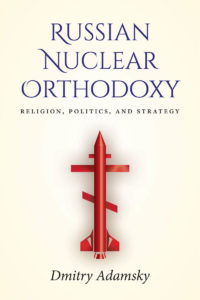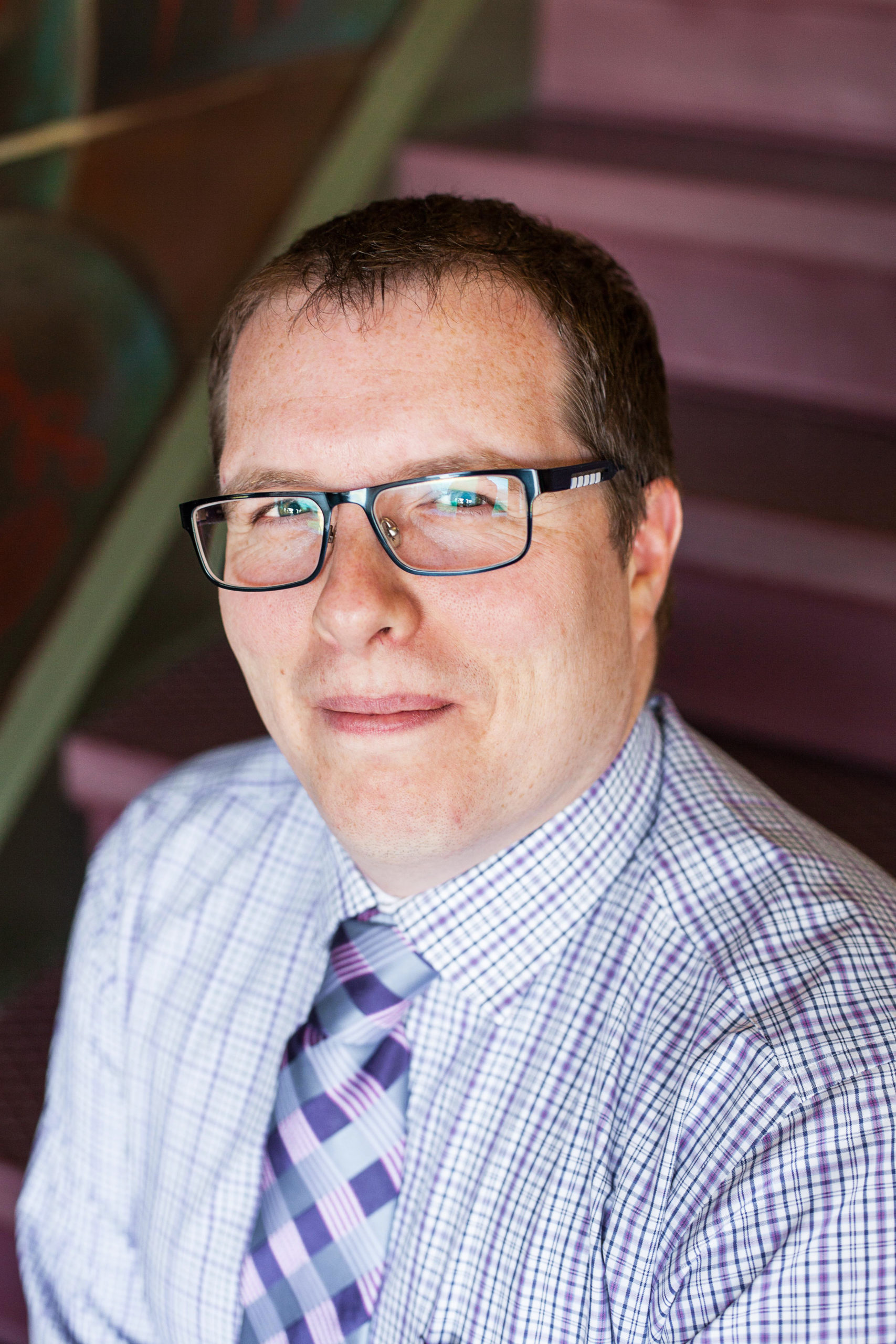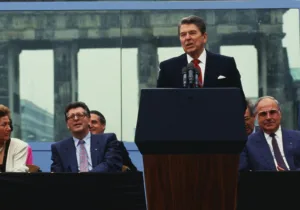In his chapter in the book Atomic Project of the USSR: Sixty Years of Russia’s Nuclear Shield, “St. Seraphim and Nuclear Weapons,” the archiepiscop of Nizhni Novgorod argues that the inception of the Russian nuclear shield in the holy land of Sarov was divine predestination; a mighty weapon to defend the faithful from without, just as the Orthodox faith sustains and defends them from within. From the moment Sarov “stood up to Los Alamos,” he writes, “endless fear turned into a balance of fear… the end of the nuclear monopoly was laid down here, in Sarov, in the cell of Father Seraphim, who commanded the faithful to seek a peaceful spirit… Their spiritual labor is reminiscent of the spiritual retreat of the hermit-monks in their cells. Today, they often recall that the word ‘Seraphim’ in Hebrew means ‘the burning’ and see the great saint as the patron of nuclear scientists” (112).
 This story, at the heart of what Dmitry Adamsky calls Russian Nuclear Orthodoxy in his outstanding new book of that same title, gives a piece of the religious imagination that has swept through not only the Russian nuclear arsenal since 1991, but into all levels of the nuclear triad (air, sea, land), its military forces, and even Russian foreign policy more broadly. It is an astonishing story, for its clarity, detail, and imagination, but also for how it unsettles the Western mind. How did this fallen superpower of secular-Marxism come to embrace, in a mere three decades, a worldview so permeated with holy religious language, especially centered in Russia’s famously secular military, and its mighty nuclear arsenal? That is the story Adamsky tells.
This story, at the heart of what Dmitry Adamsky calls Russian Nuclear Orthodoxy in his outstanding new book of that same title, gives a piece of the religious imagination that has swept through not only the Russian nuclear arsenal since 1991, but into all levels of the nuclear triad (air, sea, land), its military forces, and even Russian foreign policy more broadly. It is an astonishing story, for its clarity, detail, and imagination, but also for how it unsettles the Western mind. How did this fallen superpower of secular-Marxism come to embrace, in a mere three decades, a worldview so permeated with holy religious language, especially centered in Russia’s famously secular military, and its mighty nuclear arsenal? That is the story Adamsky tells.
It is a story with three acts, and although remarkably readable, no less academically serious for it. Structured into three parts—“The Genesis Decade: 1991-2000,” “The Conversion Decade: 2000-2010,” and “The Operationalization Decade: 2010: 2020”—each part is further broken down into three consistent sections: “State-Church Relations,” “Faith-Nuclear Nexus,” and “Strategic Mythmaking.” This structure is brilliant in its own way, because for those non-nuclear enthusiasts who are still interested more generally in the question of religion and foreign affairs and especially Orthodoxy and Russian foreign affairs, each part also has a detailed overview of changes to the whole context under which the “faith-nuclear nexus” forms only itself a part. This book, therefore, should not be missed by readers on religion and foreign affairs more generally. Adamsky himself lays out a crucial reason in the introduction: “The scholarship [on religion and war] suffers from case-selection bias. With few exceptions, the majority of the literature has focused on Islamic radicalism and non-state actors, but paid little attention to the nexus between nuclear weapons and religion in the militaries of the Christian world” (4).
And our attention is very much rewarded. What Adamsky demonstrates is nothing short of a remarkable transformation in Russian military and diplomatic worldview, captured in the term nuclear orthodoxy.
Nuclear Orthodoxy was coined by Maksim Kalashnikov already in 1998 (166) and rests, says Adamsky, on two pillars: to stay Orthodox, Russia should be a strong nuclear power, and to stay a strong nuclear power, Russia should be Orthodox (161). That is, in order to preserve its Orthodox character, Russia must have a strong and holy shield to protect its Christian civilization, but in order to preserve its great-power nuclear status, Orthodoxy should protect Russia within from the moral rot of Western secularism (77).
The notion evolved, says Adamsky, in three stages. First, the “nuclear mythology from the 1990s acquired critical mass toward Putin’s 2007 statement on faith and atoms. Then, following the president’s statements, Kholmogorov gave to this collection of beliefs more structure and popularized it among the general public. Finally, the notion was canonized when the Russian Doctrine project, led by the patriarch, absorbed it” (157). It was an unusual convergence, argues Adamsky, of both grassroots bottom-up (priests, soldiers, popular myths) and top-down (patriarchs, presidents, doctrines), and the convergence led to rapid canonization not only in the upper-elites of political and military classes, but in the obeisance and homage of the rank and file.
The holy armor of Russia’s nuclear arsenal is intended, under the vision of St. Seraphim, to be not a competing power of church or state, but church and state (the coveted template of symphony, never quite achieved but nostalgically recalled from Byzantium). For every new block of the nuclear station, the Russian Orthodox Church builds a new temple (109). “Nuclear priests” are posted to nuclear submarines, opening shifts with prayer, talking to sailors, confirming and sanctifying their work (214). “Underwater temples” are sacralized so sailors have places to conduct services in submarines. Icons are affixed to nuclear triggers and safeguards. The patriarch praises “the labor of the missileers maintaining strategic parity,” and insists that “missile weapons should be in clean hands” (117). Whether this religious-moral absolution of those who hold the world’s nuclear fires at bay would make them more or less likely to trigger a holocaust is a subject of some debate in Adamsky’s conclusion.
And this nuclear mythology is itself part of a larger strategic framework which labors to recast, in some cases redact, Russian and Soviet history and place it again, as it had been in Soviet historiography, at the moral center of a struggle for a just and peaceful world.
Patriarch Kirill has famously defined a new geopolitical reality, the “Russian world,” referring to the “spiritual-cultural-civilizational code of the historical Rus, of which the Russian Orthodox Church has been the creator and custodian, especially during times of trouble” (182). Russia is in this imagination the “Third Rome—as a light unto the nations—as well as in opposition to the West” (183), whose dramatic moral and material decline is directly and causally related to its abandonment of Christianity. It is a “narrative of Russia as a great power, a ‘combination of Soviet nostalgia, yearning for revenge, and historical mysticism based on Byzantine and Orthodox heritage’” (226), where to be Orthodox and to be Russian become synonymous (227). The resurrection of the Tsarist formula of “Orthodoxy, Autocracy, Peoplehood,” often with a much redacted and revised Soviet history to create continuity, is at its core. The Kremlin and the Russian Orthodox Church even picked up the mantle of “defenders of the Christian faith,” a religious narrative intrinsic to Russian interventions in Syria, and even Georgia, Crimea, and Ukraine.
Patriarch Kirill’s blueprint boils down to three basics. First, the “church should be loyal to the state regardless of regime type.” The Byzantine model of symphony is the ideal type, though aware of his Byzantine history, Kirill has always advocated for its ideal, not its actual Byzantine practice. Second, despite the constitutional separation of church and state, the Russian Orthodox Church should have a major moral and spiritual role in expressing positions on state matters, both domestic and foreign. Third, Orthodoxy must therefore have a privileged position, refusing what he calls a “multi-confessional state” preferring instead an “Orthodox country with national and religious minorities” (175).
But it is important not to overstate this vision, nuclear or otherwise, and suggest it has been overwhelmingly representative of Russian society or state. While self-identification in the Russian population with Orthodoxy has soared (from 37 petrcent in 1991, to 80 percent in 2017), only 17 percent pray daily, and less than 15 percent attend services once a month or more (174). The Russian Orthodox Church therefore sees its main task as turning declared believers into practicing belongers. It is not hard to conclude that even this vision of the “Russian world” and an “Orthodox civilization” may yet be a mile wide but an inch deep. Still, the Church is catching up very fast.
All of this is worked out against a backdrop of Western complacency, decadence, and smutty secularism. The rise of Russian Nuclear Orthodoxy is not only about recovering a Christian civilization with a bright, historical lineage to Kiev Rus, Constantinople, and Rome, but about the vengeful geopolitical restoration of a humiliated superpower. Such visions despise the “secular Americans and Europeans for rejecting their roots, including the Christian values that constitute the basis of Western civilization” (180-181). One senior military commander said that “the most sophisticated nuclear missiles that the Americans call ‘Satan’ are for us the ‘guardian-angels’ of Russia. Nuclear weapons are our material support. Orthodoxy is our spiritual foundation” (76). Doctrines like those of the just war tradition, themselves rooted in the Christian-Roman tradition, barely register in Orthodoxy, argues Adamsky: “In Russia there has been no systematic theological discussion yet of the strategic operational issues pertaining to nuclear weapons, including exploration of the causes and consequences of nuclear use” (246). Orthodox theology, in contrast to both Roman Catholic and Protestant theology, elaborates very little on jus ad bellum, and jus in bello has received even less attention. These Christian worlds seem as far apart now as they did in 1054.
Yet, in conclusion, Adamsky claims that we are witnessing a “major discontinuity from the past” (255). I think his same evidence could be recast to make exactly the opposite conclusion. This is not to cede ground to the modern-era Russian revisionists claiming Stalin was secretly pious or that the Soviet secularism that butchered priests and bulldozed churches was somehow an exercise in Orthodox fidelity. But it is to say, as I have argued elsewhere, that strong civil religion tends to replace strong civil religion. Adamsky even implicitly lays out the argument, saying “history has come full circle. In the Soviet era ‘red corners’ were located in public places to present an iconostasis of the ‘new saints’ of Marxism-Leninism, replacing the orthodox icons. Now, the new mythology and iconography have replaced the Soviet iconostasis with a new-old one, in which traditional Russian and newly canonized saints and warriors from Russian and Soviet history harmoniously coexist” (2). The spiritual and material exhaustion of the Soviet collapse in the 1980s made a society “unprecedently receptive to faith” (18), one that Russian clergy described as “the second baptism of Russia.” The Saraphim Sarovsky Fund sponsors prayer rooms and chapels in the barracks of nuclear missile regiments—a “reincarnation of the red corners of the Soviet Army barracks” (203). Nuclear priests stand in for the party commissariat, where “being a practicing Orthodox may become a promotion multiplier and equivalent to what membership in the Communist Party used to be” (240). The way to understand this is exactly as Adamsky lays it out in his section “The Conversion Decade”: Russian society perhaps has discontinuity in the substance of the faith, but is no less rich in its religious, apocalyptic self-understanding.
In the end, we may wonder, alongside Daniel Philpott, whether the brutal secularism of the twentieth century was not itself the deviation, not one of religion, really, but one of pretending to have no religion, or imagining away the moral and spiritual foundations on which societies so often rest. The resurgence of Russian Orthodoxy, the “Russian world,” and Russian Nuclear Orthodoxy is more continuity than discontinuity in that analysis. Or, as Philpott himself puts it, the more interesting question is not “why religion went away” but “why we ever thought it did.”
Robert J. Joustra is an associate professor of politics and international studies and founding-director of the Centre for Christian Scholarship at Redeemer University College, outside Toronto (Canada). He is an editorial fellow with The Review of Faith & International Affairs and author and editor of several books, including most recently Modern Papal Diplomacy and Social Teaching in World Affairs (Routlege, 2019). He tweets sporadically @rjoustra.
Photo Credit: Russian Orthodox Priest blesses a Soyuz-FG launch vehicle at the Baikonur cosmodrome. By Aleksei Fillipov. Source RIA Novosti.






